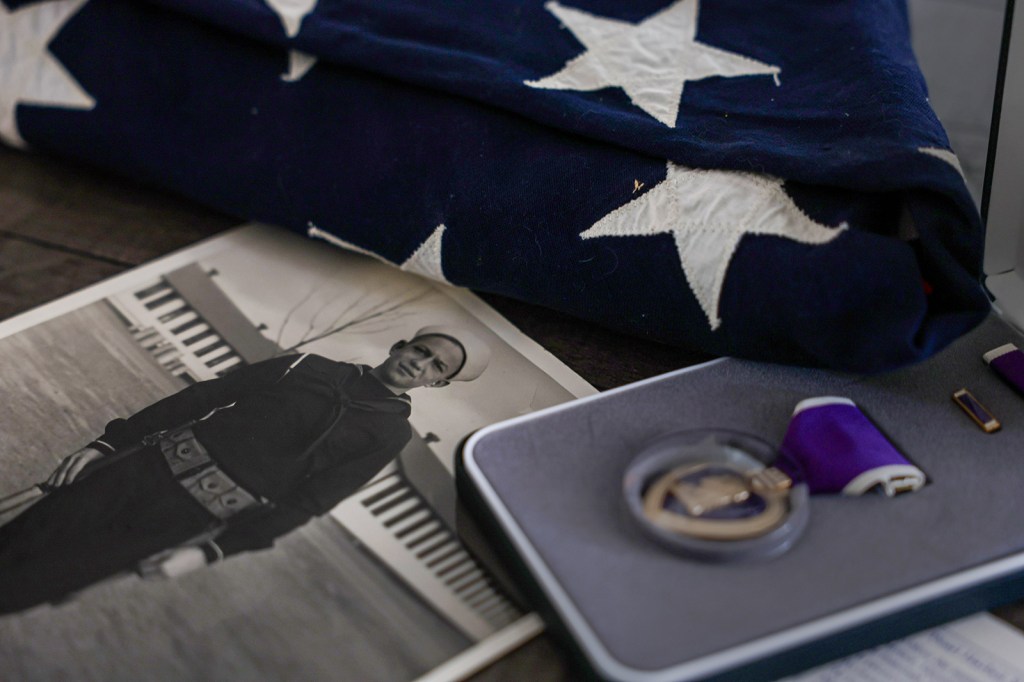Thomas Curwen | (TNS) Los Angeles Times
LOS ANGELES — No one knows where Everett Titterington was when the first torpedoes slammed into the USS Oklahoma on that infamous day in 1941. Was he thrown out of his bunk? Was he thrown to the deck? Did he die fast, or did he die slow?
The force of the explosions, as one survivor recounted, seemed to lift the massive battleship out of the water before it settled and, within 15 minutes, capsized. Titterington was one of the 429 sailors and Marines attached to the Oklahoma, who were killed during the attack, and one of the 2,400 who perished at Pearl Harbor.
When the news reached Milford, Iowa, Titterington’s hometown, details were sketchy. His family had to wait almost two weeks before a telegram arrived, addressed to his mother.
The Navy Department deeply regrets to inform you that your son Everett Cecil Titterington Fireman First Class US Navy is missing….
Hardship and grief seemed forever braided into Pearl Titterington’s life. She had lost her husband 15 years earlier — in a scaffolding collapse — leaving her with five children, ages 15 months to 6. The family had weathered the Depression, but now the country was at war and Everett, her oldest boy, would soon be reported dead.

A new sorrow had forced itself into her home, an unwanted guest she and her children made room for, and every year on Dec. 7, they were reminded of its unwanted presence in their lives.
The country’s public honoring of those lost at Pearl Harbor never quieted their grief, the stories they told themselves, the words they shared, the feelings they passed from one generation to another.
“It’s never been about Pearl Harbor for me,” said April McKinnon, Pearl Titterington’s great-granddaughter. “It’s always been about the uncle who never came home.”
Some service members killed aboard the Oklahoma were identified, but most, like Titterington, were laid in mass graves, marked “Unknowns,” in a cemetery on a hill above Honolulu.
Unknown until the phone rang this year, and McKinnon was told that bones had been identified through DNA analysis as Titterington’s. Her great-granduncle was coming home.
Sitting with the news of Titterington’s imminent return, McKinnon felt a familiar current of grief sparking inside her, but this time it was different, as if it had suddenly branched throughout the family tree. She wanted to tell her mother, who had died two years earlier. She wanted to tell her grandmother, who died in 1994. She wanted to tell her great-grandmother, who died in 1964.
“Their dreams and thoughts and hopes were passed onto us, but also their sorrow,” she said.
Yet McKinnon also felt something else. Wiping away tears, she wondered: Was it happiness and pride as well?
Grief is an uneasy inheritance, but McKinnon had accepted its terms. If generations of women before her could bear this pain, then so could she. Just as Titterington had been in their lives, so had he been in hers.
Yet still she puzzled over this man, whose life she never knew but for fragments of memory and family lore. She pulled out a large Tupperware box she had stored in her garage in Rancho Mirage after she and her sister, Lora Parrish, had cleaned out their mother’s home two years ago.

Inside were a folded American flag, a Purple Heart, decorations and medals, a certificate signed by President Lyndon B. Johnson, gold-fringed souvenir pillow cases from Hawaii and California that Titterington had brought home, pages from an old family album and an 8×10.
Standing in his apprentice seaman uniform, he looked like a child playing soldier. At 5-foot-7 and 137 pounds, according to enlistment papers, he was a wisp. Blue eyes, ruddy complexion and light brown hair, he reminded her of her grandmother.
McKinnon studied the image, so outlined in grief. She knew Titterington not for who he was but for the emptiness he left behind.
Everett Cecil Titterington was born Aug. 25, 1920, in the heart of America’s Corn Belt, in a town of 440 residents, close to the Minnesota border. His parents were eager to start a family, and in five years, they had five children, which only made his father’s death at the age of 26 all the more tragic.
Fatherless at 5, Titterington grew up close to his uncle’s family, who started calling him Buzz. He joined the Boy Scouts and attended school through eighth grade and worked for a year as a bar boy at Ye Olde Town Tavern.
In 1937, he enrolled in the Civilian Conservation Corps, which got him out on his own: farmwork for room and board, clothing and a salary. Every month, he sent home $25.
Not quite 19, he set his sights on the Navy. For references, he listed the mayor, the butcher, the dairyman and the service station operator, and his mother signed papers saying that she wouldn’t request his early discharge.
After training 30 miles north of Chicago on Lake Michigan, he was eventually posted in March 1940 to the Oklahoma, based in Pearl Harbor as part of the Pacific Fleet. A fireman first class, he worked next to the boilers that powered the World War I-era ship.
The small-town boy had traded the big skies and furrowed plains of the Midwest for the blue Pacific stretching to the horizon.
Furloughed once, he made it home in early 1941, buying his niece, less than a year old, a sweater set and presenting his uncle with a ring that he had made from a 50-cent piece.
When imperial Japan attacked Pearl Harbor, Titterington had just turned 21, and for 18 months the Oklahoma would be his watery grave, lying semi-submerged on its side in the mud flats of the harbor until righted for salvage and specialists entered its catacombs to retrieve his remains and those of his fellow servicemen.
McKinnon tried to imagine what his mother might have felt upon learning that her son was missing. Not quite a year ago, McKinnon had danced with her own son at his wedding. He was 26, his life just starting.
That joy was stolen from Pearl Titterington the moment she opened the telegram, and while the Navy appreciated her “great anxiety” and promised to provide more information when it could, it also asked her to not “divulge the name of his ship or station.”
McKinnon — grieving the loss of her mother and, more recently, a dear friend — wondered how her great-grandmother coped. Even though friends and neighbors expressed condolences, Pearl Titterington could not really engage with them. All she could say was he had been at Pearl Harbor.
“Everyone who grieves has questions,” McKinnon said, “but she had no answers.”
Little wonder that seeds of doubt took hold. Maybe Titterington wasn’t dead. Maybe he was on another ship. Maybe he’d gone ashore for breakfast. Maybe he was wounded, misidentified, forgetful of who he was.
Maybe the Navy was wrong — wrong even when he was officially declared dead two months later and the Bureau of Medicine and Surgery issued a certificate of death in his name with instructions “to inter locally all bodies recovered.”
Without a body, how did they know he was dead?
His mother sat at her desk and wrote the Navy back.
Dear Sirs, I am writing you in regard to my son Everett Cecil Titterington Firman [sic] 1C, lost at Pearl Harbor, Dec. 7th, 41 ship USS Oklahoma. Could you give me any information as to how he met [his] death? If you are authorized to do so, [I] would be ever so grateful.
A week later, the Navy replied. Titterington had lost his life in the performance of his duty and in the service of his country. Cmdr. A.C. Jacobs extends his sincere sympathy.
Living in the unheated home where she’d raised her children, the 45-year-old bereaved mother eventually broke ties with Milford. She cashed the $492 death gratuity and moved to San Bernardino, soon joined by her oldest daughter, Mildred.
Iowa seemed a long ways away, but it was really never very far.
Family stories lie on the edge of history, just beyond the textbooks and official accounts in a realm where the past is always present.
As a little girl, McKinnon hung on to the words of her grandmother, Mildred Watson, and the stories she told at her dining room table, over her glass of wine, or coffee with a slice of lemon cake, about growing up in the Midwest, the bitter cold winters, the father she never knew — and the brother who went to war and never returned.
Watson did all that she could to keep her brother’s memory alive.
From her porch in Rialto she hung the American flag with 48 stars that her mother had received from the Navy. She spoke about Titterington at Elks Club luncheons, at gatherings of the Professional Business Women’s Assn. and on Thanksgiving, when she invited airmen from Norton Air Force Base for dinner.

McKinnon heard the pride and sadness that crept into her grandmother’s voice and, because hope can’t be sustained indefinitely, a begrudging acceptance of his fate.
When Watson died in 1994, her daughter Sharon Baxter and her children — McKinnon and her siblings — became keepers of Titterington’s story. Now it was now rooted less in his possible survival than his final hours.
They had heard stories that some sailors, trapped inside the Oklahoma, had lived for hours — even days — before succumbing. They had pounded on the side of the hull trying in vain to get attention of the world outside.
When they fell silent, they were lost to their families — lost until one day almost 10 years ago when phones across the country began to ring.
The laboratory was located inside an old bomber factory at Offutt Air Force Base on the outskirts of Omaha. Seventy years earlier, the Enola Gay — the B-29 super fortress that dropped an atomic bomb on Japan — was built inside these walls.
Now, in the converted space, on rows of stainless tables, lay 13,000 bones exhumed from 46 graves — and 62 caskets — from the cemetery on the hill above Honolulu. The Department of Defense had undertaken the arduous task of disinterring and sorting through the commingled skeletons. Out of this charnel house where an American flag hung at one end, technicians hoped to identify 388 sailors and Marines from the Oklahoma.
When Baxter answered her phone, the voice on the other end said she was from the Navy. They were working with the Defense POW/MIA Accounting Agency, and as best as Sharon Baxter could understand, they might have found Uncle Everett.
Her daughter was immediately suspicious. “Mom, are you sure this isn’t a scam?” McKinnon asked. “Watch what you say.”
When a DNA sampling kit arrived in the mail — cotton swabs and vials — Baxter and McKinnon’s sister, Parrish, obliged.
A few months passed, then a few years. The family lost track of time. McKinnon was diagnosed with cancer and underwent treatment. The pandemic came and went, and in 2022, her mother died after a lingering illness. Among her final words: Don’t forget about Everett.
McKinnon knew that would never happen. She and her sister and brother were now his next of kin.
Combing through the Tupperware box of Titterington’s things, McKinnon felt the impact of a life ending so abruptly.
“When mom passed, I knew all about her, and it was easy to let go,” she said. “Her story had been told from the beginning, the middle and end. It was hard, but it was acceptable. For Everett, it was never acceptable. There was no end.”
When the Navy finally called back, McKinnon was more annoyed than excited. Too much time had passed. But the Navy wanted to meet.
Sitting at a table in a conference room in the VFW Hall in Palm Springs, she and her sister listened to what two uniformed officers had to say. They had a book, almost 200 pages, and began leafing through it.
“They started showing us pictures of what Pearl Harbor looked like and the Oklahoma — everything I had seen all my life,” McKinnon said.
One page followed another, pretty much all old news. Then the words got technical and statistical: Y chromosomes, mtDNA, an occurrence 9.04 million times more likely.
Then they turned the page to a picture of Titterington’s skull. Her great-granduncle’s empty eyes stared at her, and she began to cry.
No one knows what Everett Titterington would have said about all the commotion.
When Southwest Airlines Flight 883 touched down at Ontario airport in September, its passengers were briefly delayed as a flag-draped casket was removed from the cargo hold.
On the tarmac, standing at attention and saluting, were sailors in their dress whites and an honor guard in service dress blues and campaign hats. Firefighters stood behind them.

McKinnon put her arms around her sister and brother. With tears in their eyes, they approached and touched the casket and hugged one another. Five days later, Everett Cecil Titterington Fireman 1st Class was buried at Riverside National Cemetery.
During the ceremony, McKinnon sat next to Titterington’s 91-year-old cousin from Northern California, Mary Hambrock. They hadn’t known about each other until two weeks earlier. Hambrock was 8 years old when Titterington died and could remember him sitting in her home in Milford drawing pictures for her. At the funeral she wore the ring he had made for her father on a chain around her neck.
McKinnon had never seen it before.
“It’s like freeing a ghost that’s been trapped,” she said. “It’s an answer to something that’s been haunting my family for so long.”
She now knows why her family never wanted to believe that Titterington had been killed aboard the Oklahoma.
“His death wasn’t the script that life is meant to follow,” she said. So Pearl, Mildred and Sharon had imagined him alive, getting married, having children, watching his grandchildren.
“But every story has an ending,” McKinnon said, “even if the answers are not what you want, and whether you like that ending or not, we all need closure.”
Titterington was the 328th serviceman who died aboard the Oklahoma to be identified by the Defense POW/MIA Accounting Agency, which has reunited 362 families. Since World War II and all the conflicts that have followed, more than 81,000 American service members remain missing in action.
©2024 Los Angeles Times. Visit at latimes.com. Distributed by Tribune Content Agency, LLC.

















































